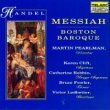[Set 3: Alto recitative and air and chorus (D major), RECITATIVE (ALTO)Behold, a virgin shall conceive, and bear a son, The complex energy of the purification scene dissipates, and the entire atmosphere softens into D major. The alto’s simple unaccompanied recitative suggests the unassuming nature of the Virgin, and its major key opens the door to a brighter prophecy that brings us closer to the birth of Messiah. [Excerpt 14] AIR (ALTO) AND CHORUSO thou that tellest good tidings to Zion, get thee up into the high mountain, Expectation of Messiah’s presence brings great joy, which Handel casts as a sweetly flowing gigue. The first and second principal violins together play a wonderfully glimmering, dancing melody that both introduces the alto and then answers the vocal line between phrases. This violin melody appears in a high range then suddenly shifts two octaves lower; the range bifurcation suggests the high and low geography mentioned in the text: the messenger of the good news is instructed to get up “into the high mountain”, from where the proclamation may be better heard abroad. [Excerpt 15] “Lift up...thy voice...with strength; lift it up...be not afraid” occurs on a rising sequence. From the pinnacle of that sequence the listener is told to “behold your God!” [Excerpt 16] A long, florid, rising sequence on the word “glory” projects the far-reaching splendor of the “light” that “is come.” [Excerpt 17] The alto’s air melds into the answering chorus, taking the message fugally into each voice for a short time. Then bold homophony takes over. “Arise” is declaimed so clearly as to be a command, and “say unto the cities of Judah, Behold your God!” is a commission from the unified voices. [Excerpt 18] ACCOMPAGNATO (ACCOMPANIED RECITATIVE) (BASS)For behold, darkness shall cover the earth, and gross darkness the people; Franz Joseph Haydn composed his famous portrayal of the creation of light at the beginning of his oratorio Die Schöpfung (The Creation) in 1797. He may well have been strongly influenced in his treatment of that moment by this recitative and the following air in Messiah, which he had heard at least in part in England and probably also in Mozart’s reorchestration earlier that decade in Vienna. This recitative in particular is one of the most vivid portrayals of the distinction between darkness and light prior to Haydn’s.
|



